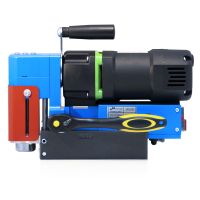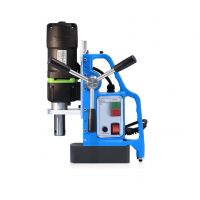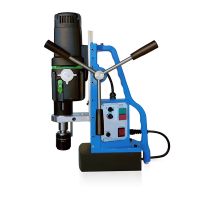While buying a Mag Drill is not the same financial commitment as some other workshop machinery, giving the decision some commercial consideration will still pay dividends.
What should I look for?
Just like any other technical product, it’s easy to buy one that’s not well suited to your needs, so your starting point should be to take an honest look at your priorities. For example, if you are looking for a machine that will take the widest cutters, you’ll have to pay more for that capacity or if you need it to be a low purchase price, you’ll probably need to compromise on the capacity. Your particular set of considerations will depend on what you intend doing with the machine, but the following list should be a good starting point for defining your priorities:
1 – Cutter capacity. What jobs will you be doing with the machine? What size holes will you need to be cutting? Remember that the diameter is only one part of the equation, consider the maximum depth needed, too, both the cutter depth and the machine stroke may be important.
2 – Cutting power. Bigger holes need bigger torque which generally means bigger, more powerful motors. Look at the wattage of the motor but also consider the RPM of the tool.
3 – Magnetic adhesion. The more torque you’re going to create, the more the magnet has to resist it. But there are also other factors to think about here, like will you need a magnet base that allows you to swivel the machine around or slide back & forth to position the cutter in awkward locations?
4 – Tapping and other tools. Do you need a reversible machine that can tap as well as drill? Machines with tapping capability usually come with a variable speed function, which may be useful to you in other applications. Will you need to create large countersinks, or maybe you’ll want to drill well below the machine base, requiring a long stroke?
5 – Safety, ergonomics & tractability. Look for features such as a safety cut-out if the magnet is not working, overload protection, sliding cutter covers and solid, secure grip handles. Are the buttons & switches easy to operate, even in real-world situations? Internal coolant delivery can make life easy on the job, and well designed cases & handles make for easy operation when wearing full PPE.
6 – Reliability & build quality. Look for solid body castings and go for well-engineered slides and pinions. Cheaper dovetail slides can often loosen with use, either through use of softer materials or from the design not allowing enough bulk around the slide, and this will lead to reduced accuracy, broken cutters and even failure of the casting. Choose machines with good quality motors for long term reliability. A good tip is to consider where the machines were made – go for countries or regions where compliance with stringent quality and safety controls are mandated to ensure a quality product and long service life. Be aware that cheaper machines are often made in low-cost-of-labour regions but use clever marketing or branding to suggest more kudos than they deserve. Remember that “made in…” is not the same as ‘manufactured in…”, with some brands being assembled from parts sourced from cheap labour regions.
7 – Don’t forget the low-pro option. If you are likely to need a machine that will allow you to work in the smallest spaces inside beams and other tight spots, most manufacturers offer a low profile option to suit. Avoid just picking a low-pro model because the rest of the range looks good, though, apply the same criteria as you would the other models. Ignore unqualified marketing claims and check out the numbers to see if it’s as low as you need, some low profile models are lower than others, so look at the overall height and the over-cutter height where specified. Look for foldable carry handles, reversible ratchet handles and other space-saving design features, but always remember to look at the quality of the components used – just because it’s low profile doesn’t mean you shouldn’t expect a quality product! Another really important thing to consider with low-pro models, do they require the use of special proprietary (and often expensive) cutters or can you use the cheaper standard tools?
8 – Price versus cost. Sometimes it’s a valid choice to go for the cheapest you can get, like the throw-away tools left in skips on building sites. More often, and especially with tools like mag drills, you’re going to want some longevity from your investment. Generally, a cheapest-sticker-price machine is not going to be the one to give you the longest serviceable life and even when they do go on for years, they often require more replacement parts to keep them going than their inherently better quality alternatives. And you might want to think about the long-term availability of those parts, too, especially from unknown brands with eyecatching price deals. Of course, if your users are going to throw them into a ute and drive 100km to the site, you may not want to buy the best you can get but if you and your staff value good, reliable and efficient tools, buy the best you can afford, it will pay you back in the long run. Also, if possible go for a model or two above what you need. A machine that runs at or near its capacity most of the time will not last as long as one that spends most of its time at 50%, plus you never know when that extra capability could be the difference between getting that bigger job or not being able to quote for it.
Summary
Like so many manufactured products, mag drills are a complex mix of production quality, cost reduction and marketing. Due diligence is required to ensure you understand what you’re buying and that’s really the key to making a good purchase – take the time to understand what you want from the machine and what value you place on those requirements. Then do your comparisons, compare the stats and see how they add up.
Buy from suppliers you trust, choose brands you can speak to people about.
Finally, ask the supplier for details if you can’t find them in the marketing. If they can’t answer you, how can they be sure it’s the right machine for you? Even more importantly, how can you be sure it’s the one to spend your money on?






